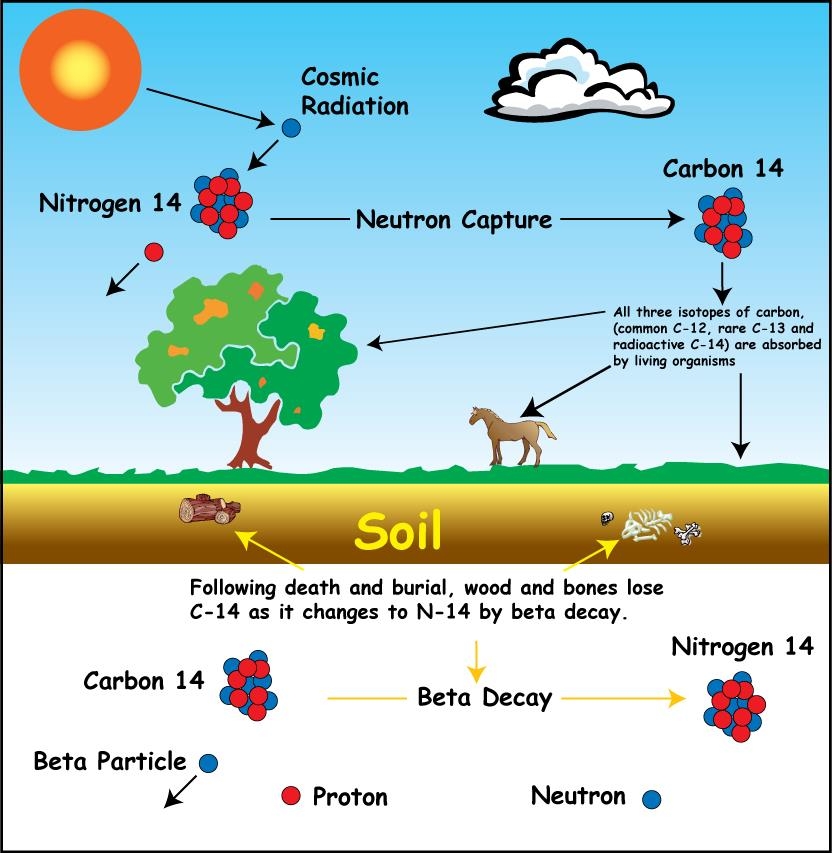Carbon dating the earth
Dating > Carbon dating the earth
Click here: ※ Carbon dating the earth ※ ♥ Carbon dating the earth
This means that the tree-ring dates would be slightly too young, not too old. Two different kinds of blank may be measured: a sample of dead carbon that has undergone no chemical processing, to detect any machine background, and a sample known as a process blank made from dead carbon that is processed into target material in exactly the same way as the sample which is being dated. Andrew Snelling has suggested that fractionation sorting of elements in the molten state in the Earth's mantle could be a significant factor in explaining the ratios of isotope concentrations which are interpreted as ages.

The Bible teaches a young universe and earth. It is not difficult to see how such a social could arise, however. Living organisms are constantly incorporating this C-14 into their bodies along with other carbon isotopes. Astronomer Gerald Hawkins found, after careful computer calculations, that the arrangement of the stones at Stonehenge are aligned with key positions of the sun and moon as they were almost 4000 custodes ago. This was demonstrated in 1970 by an experiment run by the British Museum radiocarbon laboratory, in which carbon dating the earth measurements were taken on the same sample for six months. Carbon-14 found in fossils at all layers of the geologic column, in coal and in diamonds, is evidence which confirms the biblical timescale of thousands of years and not billions. Gamma decay of an excited state of iron 57 has been studied, but this has nothing to do with the kinds of decays used in radiometric dating. Carbon 14 is used for this example:, which was put out by Dr. A third sol came from studies in Greenland.
For the scientific journal, see. Egyptian barley samples have been found which date to 17,000-18,300 years old Science, April 7, 1978. Unless this effect which is additional to the magnetic field issue just discussed were corrected for, carbon dating of fossils formed in the flood would give ages much older than the true ages. Therefore, as already noted, Dr.

The Age of the Earth - By careful counting and cross-checking he was able to determine that the oldest glacial lakes, which would have formed at the start of the retreat of the ice, were 12,000 years old.

Scientific American Editor Michael Moyer explains the process of radiocarbon dating. What is Carbon Dating? Carbon is one of the chemical elements. Along with hydrogen, nitrogen, oxygen, phosphorus, and sulfur, carbon is a building block of biochemical molecules ranging from fats, proteins, and carbohydrates to active substances such as hormones. All carbon atoms have a nucleus containing six protons. Ninety-nine percent of these also contain six neutrons. Carbon-13 and carbon-14 are thus isotopes of carbon-12. Isotopes participate in the same chemical reactions but often at differing rates. When isotopes are to be designated specifically, the chemical symbol is expanded to identify the mass for example, 13C. Illustration by Jayne Doucette, Woods Hole Oceanographic Institution Both 13C and 14C are present in nature. The former accounts for about 1% of all carbon. The abundance of 14C varies from 0. The highest abundances of 14C are found in atmospheric carbon dioxide and in products made from atmospheric carbon dioxide for example, plants. Unlike 12C and 13C, 14C is not stable. As a result it is always undergoing natural radioactive decay while the abundances of the other isotopes are unchanged. Carbon-14 is most abundant in atmospheric carbon dioxide because it is constantly being produced by collisions between nitrogen atoms and cosmic rays at the upper limits of the atmosphere. The rate at which 14C decays is absolutely constant. Given any set of 14C atoms, half of them will decay in 5730 years. Since this rate is slow relative to the movement of carbon through food chains from plants to animals to bacteria all carbon in biomass at earth's surface contains atmospheric levels of 14C. However, as soon as any carbon drops out of the cycle of biological processes - for example, through burial in mud or soil - the abundance of 14C begins to decline. After 5730 years only half remains. After another 5730 years only a quarter remains. This process, which continues until no 14C remains, is the basis of carbon dating. They are derived from biomass that initially contained atmospheric levels of 14C. But the transformation of sedimentary organic debris into oil or woody plants into coal is so slow that even the youngest deposits are radiocarbon dead. The abundance of 14C in an organic molecule thus provides information about the source of its carbon. If 14C is present at atmospheric levels, the molecule must derive from a recent plant product. The pathway from the plant to the molecule may have been indirect or lengthy, involving multiple physical, chemical, and biological processes. Levels of 14C are affected significantly only by the passage of time. If a molecule contains no detectable 14C it must derive from a petrochemical feedstock or from some other ancient source. Intermediate levels of 14C can represent either mixtures of modern and dead carbon or carbon that was fixed from the atmosphere less than 50,000 years ago. Signals of this kind are often used by chemists studying natural environments. A hydrocarbon found in beach sediments, for example, might derive from an oil spill or from waxes produced by plants. If isotopic analyses show that the hydrocarbon contains 14C at atmospheric levels, it's from a plant. If it contains no 14C, it's from an oil spill. If it contains some intermediate level, it's from a mixture of both sources.
Last updated